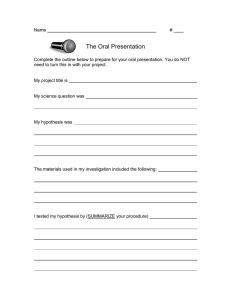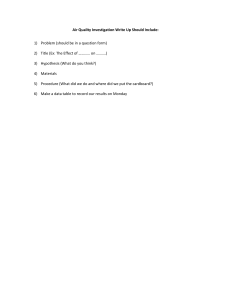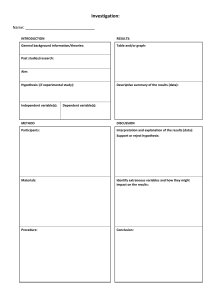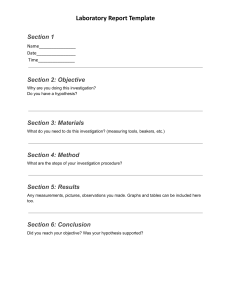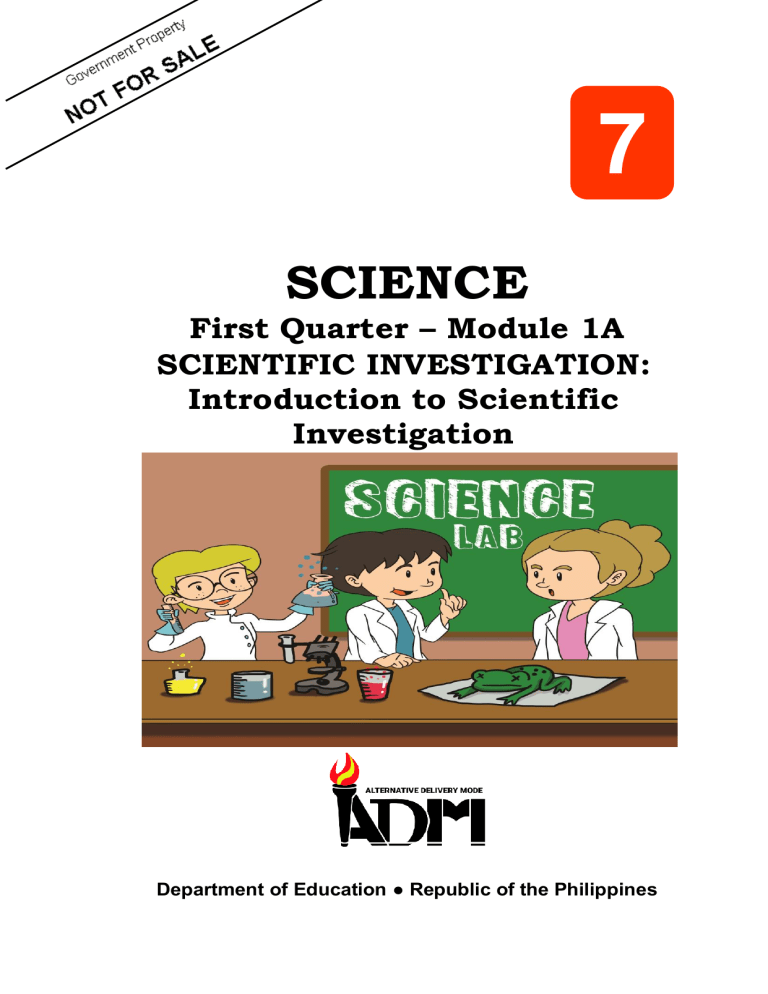
7 SCIENCE First Quarter – Module 1A SCIENTIFIC INVESTIGATION: Introduction to Scientific Investigation Department of Education ● Republic of the Philippines Science – Grade 7 Alternative Delivery Mode First Quarter – Module 1: Introduction to Scientific Investigation First Edition, 2020 Republic Act 8293, Section 176 states that: No copyright shall subsist in any work of the Government of the Philippines. However, prior approval of the government agency or office wherein the work is created shall be necessary for exploitation of such work for profit. Such agency or office may, among other things, impose as a condition the payment of royalties. Borrowed materials (i.e., songs, stories, poems, pictures, photos, brand names, trademarks, etc.) included in this module are owned by their respective copyright holders. Every effort has been exerted to locate and seek permission to use these materials from their respective copyright owners. The publisher and authors do not represent nor claim ownership over them. Published by the Department of Education Secretary: Leonor Magtolis Briones Undersecretary: Diosdado M. San Antonio Development Team of the Module Author/s: Reviewers: Evaluators: Illustrator and Layout Artist: Management Team Chairperson: Co-Chairpersons: Rizza Mae L. Serino Marisol P. Moreno Norlyn Q. Lobido Marissa M. Olarte Ferdinand Bonito L.Taclob Jr. Decy Joy V. Jabonilla Rudnie Rosala Spark Erl E. Balicog Myraflor E. Besire Marissa R. Bueno Dr. Arturo B. Bayocot, CESO III Regional Director Dr. Victor G. De Gracia Jr. CESO V Asst. Regional Director Edwin R. Maribojoc, EdD, CESO VI Schools Division Superintendent Myra P. Mebato,PhD, CESE Assistant Schools Division Superintendent Mala Epra B. Magnaong Chief ES, CLMD Members: Neil A. Improgo, EPS-LRMS Bienvenido U. Tagolimot, Jr., EPS-ADM Samuel C. Silacan, EdD, CID Chief Maritess A. Caguindangan, EPS - Science Rone Ray M. Portacion, EdD, EPS – LRMS Asela I. Elumbareng, EdD, PSDS Nelia T. Lanzaderas, PhD, Principal III/District In-charge Agnes P. Gonzales, PDO II Vilma M. Inso, Librarian II Printed in the Philippines by Department of Education – Division of Misamis Occidental Office Address: Osilao St., Poblacion I, Oroquieta City, Misamis Occidental Contact Number: (088) 531-1872 / 0977 – 8062187 E-mail Address: deped_misocc@yahoo.com 7 Science First Quarter – Module 1A SCIENTIFIC INVESTIGATION: Introduction to Scientific Investigation This instructional material was collaboratively developed and reviewed by educators from public secondary schools from the Division of Misamis Occidental. We encourage teachers and other education stakeholders to email their feedback, comments, and recommendations to the Department of Education at action@ deped.gov.ph. We value your feedback and recommendations. Department of Education ● Republic of the Philippines Introductory Message For the Learner Welcome to an enjoyable learning adventure through Alternative Delivery Mode (ADM) Module as we capture another journey to the world of Science 7. Have you ever wondered how scientists discover their scientific breakthroughs? Will it be possible for a Grade 7 learner like you to do science the way your favorite scientist did? No need to worry, boys and girls! In this module, we will learn to do exciting and fun-filled investigation through the scientific method. This module was designed to provide you with fun and meaningful opportunities for guided and independent learning at your own pace and time. You will enable to process the contents of the learning resource while being an active learner. This module has the following parts and corresponding icons: What I Need to Know This will give you an idea of the skills you are expected to learn in the module. What I Know This part includes an activity that aims to check what you already knew about the lesson to take. If you get all the answers correct (100%), you may decide to skip this module. What’s In This is a brief review to help you connect the current lesson with the previous one. What’s New In this portion, the new lesson is introduced to you in many ways in a form of story, song, poem, problem opener, activity or situation. What is It This section provides a brief discussion of the lesson. This aims to help you discover and understand new concepts and skills. What’s More There are self learning activities for independent practice to measure your understanding and skills of the topic. You may check the answers to the exercises using the Answer Key at the end of the module. What I Have Learned This includes questions or blank sentence/paragraph to be filled in to process iv what you learned from the lesson. What I Can Do This section provides an activity which will help you transfer your new knowledge or skill into real life situations or concerns. Assessment This is a task which aims to evaluate your level of mastery in achieving the learning competency. Additional Activities In this portion, another activity will be given to you to enrich your knowledge or skill of the lesson learned. This also tends retention of learned concepts. Answer Key This contains answers to all activities in the module. The following are some reminders in using this module: 1. Use the module with care. Do not put unnecessary mark/s on any part of the module. Use your Science activity notebook in answering the exercises. 2. Don’t forget to answer What I Know before moving on to the other activities included in the module. 3. Read the instructions carefully before doing each task. 4. Observe honesty and integrity in doing the tasks and is checking your answers. 5. Finish the task at hand before proceeding to the next. 6. Return this module to your teacher/facilitator once you are through with it. If you encounter any difficulty in answering the tasks in this module, do not hesitate to consult your teacher or facilitator. Always bear in mind that you are not alone. We hope that through this material, you will experience meaningful learning and gain deep understanding of the relevant competencies. You can do it! v TABLE OF CONTENTS What I Need to Know ……………………………………………………..... 1 What I Know ……………………………………………………….. 2 What’s In ……………………………………………………….. 3 What’s New ……………………………………………………….. 4 What is It ……………………………………………………….. 5 Steps in Scientific Method ………………………………………….. 5 What’s More ………………………………………………………... 9 ……………………………………………………… 10 What Can I Do ………………………………………………………. 11 Assessment ……………………………………………………….. 12 Additional Activities ……………………………………………………….. 13 Answer Key ……………………………………………………….. 14 References ……………………………………………………….. 15 What I Have Learned vi What I Need to Know Investigation is the heart of science. It is the way scientists do research. Scientific investigation is a way to find answers to a question that will produce evidences that help you answer questions and solve problems. When the evidence cannot provide answers or solutions then it may lead to new questions or problems for investigation. As more knowledge are discovered, science advances. Researchers investigate the world in so many ways. In different fields of science, they may use different methods and be guided by different theories and hypotheses but most of them generally follow the steps in a Scientific Investigation. After going through this module, you are expected to describe the components of a scientific investigation (S7MT-Ia-1). Specifically, you are also expected to: 1. identify the steps in scientific method. This module was designed and written with you in mind. It is here to help you understand the process of Scientific Investigation. The scope of this module allows you to use different learning situations. You need to be patient in doing your tasks. Follow the directions in the activities and answer the given test and exercises properly. 1 What I Know Matching Type. Directions: Match the following terms in Column A with the correct definition in Column B. Choose the letter of the best answer. Write the chosen letter in your Science notebook. Column A Column B _____ 1. Hypothesis A. A conclusion based from evidence and reasoning _____ 2. Control B. A formal inquiry or systematic study _____ 3. Investigation C. A judgment based on the results of an experiment _____ 4. Dependent Variable D. A sequence of steps involved in performing experiment _____ 5. Experiment E. A temporary solution to a problem _____ 6. Conclusion F. Any information that is gathered with the use of senses _____ 7. Data G. Can change or influence the result of the experiment _____ 8. Communicate H. Observations & measurements recorded _____ 9. Observation I. Organized process to test a hypothesis _____ 10. Independent Variable J. Sharing the results to get helpful feedback _____ 11. Interpret K. The inquiry or problem relating to a topic _____ 12. Variable L. The factor that is manipulated during an experiment _____ 13. Record M. The response that is measured in an experiment _____ 14. Question N. To interpret or give meaning _____ 15. Procedure O. To write accurate information about what occurs during experiment P. Used to show that the result of an experiment is really due 2 Lesson 1 Introduction to Scientific Investigation What is Scientific Investigation? Scientific Investigation is the way in which scientists and researchers use a systematic process to answer questions about the world around us. It is a way of finding the answer to a question using the carefully arranged steps. In other words, the scientific method is a systematic process that involves measurable observations to formulate, test or modify and prove a hypothesis. What’s In Activity 1: Arrange Me! Below are steps in scientific investigation, arrange the following steps in the proper order. Write numbers 1-7 (1 being the first step and 7 as the last step). Write your answers in your Science activity notebook. ______________ a. Find out the problem ____________ b. Observe and record ____________ c. Make a hypothesis/ temporary solution or answer ____________ d. Communicate the result ____________ e. Identify the problem ____________ f. Arrive at a conclusion/ making of general statement ____________ g. Test the hypothesis 3 What’s New Activity 2: Vocabulary Match! Directions: Match the vocabulary words in the box to their definitions below. Write the letter of your answer in your Science activity notebook. VOCABULARY A. Scientific Method E. Ethical I. Observe B. Questions F. Variable J. Record C. Experiment G. Hypothesis K. Conclusion D. Research H. Procedure L. Interpret 1. To explain or give meaning 2. Notice what occurs during an experiment. 3. Something that can change or influence the results of an experiment. 4. The inquiry or problem relating to a topic that can be answered by conducting an experiment. 5. A method of doing research that includes the steps of identifying a problem, gathering data, forming a hypothesis, testing a hypothesis, and drawing a conclusion. 6. Following the rules of being fair and honest. 7. An educated guess or reasonable assumption. 8. To conduct an investigation into current information about something. 9. A test or trial performed in order to discover something. 10. The result or outcome of something. 4 What is It Steps in Scientific Method Scientists are, by nature, keen observers that is why they can easily perceive areas where problems exist. Having identified the problem, scientist undertakes a carefully planned investigation following a systematic and logical approach using steps in scientific method. The figure below shows the steps in Scientific Investigation. Figure 1. Steps in Scientific Investigation 5 1. Identifying Problems – The first step in scientific investigations is to identify a problem in a given situation. This problem comes when a researcher is curious or interested about something he/she has observed in the environment. 2. Making Observations – The process of science starts with an observation within the surrounding of a researcher. In this step, the scientist will research and make observations regarding the problem. 3. Forming a Hypothesis – In this step, you will give temporary solutions to the identified problem. 4. Testing the Hypothesis/ Experiment – The next scientific step you are going to is to test your hypothesis. Some hypothesis may be tested simply by further observations or take an elaborate and tedious process experiment. 6 as in the 5. Organize and Analyze Data - After performing an experiment and collecting data, one must analyze the data. Research experiments usually analyzed data with statistical software in order to determine the relationships among the data gathered. In the case of a simpler experiment, one would look at the data and see how they show a relationship. 6. Draw Conclusions – The next step of scientific investigation is to form a conclusion. If the data support the hypothesis, then the hypothesis is correct and may be the explanation for the phenomena. If the data do not support the hypothesis, then more observations must be made, a new hypothesis is formed, and the scientific investigation is used all over again. 7. Communicate Results - When a conclusion is drawn, the research can be presented to others to inform them of the findings and receive input about conclusion the drawn validity from of the the research. 7 What’s More Activity 3: Fill in the Blanks Directions: Fill in the blanks with the appropriate words from the vocabulary list inside the box. Write your answers in your Science activity notebook. scientific method: a method of doing research that includes the steps of identifying problem, gathering data, forming a hypothesis, testing a hypothesis, and drawing a conclusion question: the inquiry or problem relating to a topic that can be answered by conducting an experiment experiment: a test or trial performed in order to discover something hypothesis: an educated guess or reasonable assumption procedure: a sequence of steps involved in performing an experiment observe: to notice what occurs during an experiment record: to write accurate information about what occurs during an experiment interpret: to explain or give meaning to conclusion: the result or outcome of something variable: something that can change or influence the results of an experiment ethical: following the rules of being fair and honest research: to conduct and investigate into current information about something The _________________ method is one way that people think about and solve questions or problems. When you begin your experiment, it is important to state a problem or _________________ that you would like to find an answer to. It is important to look up or _________________ up-to-date information about your topic before you conduct any experiments. A(n) _________________ is a possible explanation about something. 8 To conduct a(n) _________________ is a good way to discover something new about science. Be sure to write down each step or _________________ in the correct order before you start your science experiment. When you conduct an experiment and you deliberately change one thing, you are introducing a(n) _________________. It is critical to watch or _________________ what is happening with every step of your experiment. After you conduct your experiment, a valuable step is to write down or _________________ what happened. When you explain what happened in your experiment, you _________________ the results. Sharing true information about the outcome of your experiment is an example of _________________ behavior. After an experiment, it is important to write down your _________________ or summary of what you learned. What I Have Learned Given the situations below, choose the letter that corresponds to your answer and write an essay about what is ask in number two (2). Write your answers in your Science activity notebook. 1. The mother of John wanted to find out the effect of organic fertilizer in the growth of pechay plant. What are the steps she is going to follow in order to find out the effect on the growth? a. conduct an experiment, form a hypothesis, make a conclusion, record data b. form a hypothesis, record data, conduct an experiment, make a conclusion c. form a hypothesis, conduct an experiment, record data, make a conclusion d. record data, form a hypothesis, make a conclusion, conduct an experiment 2. How do steps in scientific method help in solving problems? 9 What I Can Do Activity 4. Identify and Arrange Me! Directions: Identify what step is being illustrated in each picture and arrange the following pictures using numbers 1-5 (1 being the first step and 5 being the last step). Write your answers in your Science notebook. . a. . Photo Credits: Rizza Mae L. Serino ____________ _____________ _________________________ _________________________ c. d. ____________ _____________ _________________________ _________________________ 10 e. f. Photo Credits: Rizza Mae L. Serino ____________ _____________ _________________________ _________________________ EXCELLENT! You are now done with all the activities in Module 1A. Ready for the Assessment? 11 Assessment Directions: Now that you are finished accomplishing this module, let us check your understanding about the lesson presented in this module. Each sentence below describes a step of the scientific method. Match each sentence with a step of the scientific method listed below. Write the letter of your answers in your Science activity notebook. A. Draw conclusions C. Recognize a problem B. Form a hypothesis D. Test the hypothesis/ Experiment _______ 1. RJ Lou grew mongo seeds in ten (10) pots. She divided the pots into two (2) groups, the five (5) pots exposed to sunlight and the rest five (5) pots inside their house. _______ 2. Krizha used a survey to determine how many of her classmates were left-handed and how many were right-handed. _______ 3. Jose wanted to find out the effect of commercial fertilizer from organic fertilizer in the growth of tomato. _______ 4. Vincent saw bats catching insects after dark. He asked, “How do bats find the insects in the dark?” _______ 5. Mar wondered if dyes could be taken out of plant leaves, flowers, and stems. _______ 6. Florence soaked six different kinds of seeds in water for 24 hours. Then she planted the seeds in soil at a depth of 1 cm. She used the same amount of water, light, and heat for each kind of seed. _______ 7. Celso read about growing plants in water. He wanted to determine how plants could grow without soil. _______ 8. Jade said, “If I grow five seedlings under the sun, I think the plants will grow slower than the five plants grown inside the house.” _______ 9. Maria’s experiment proved that earthworms move away from light. 12 _______ 10. Neil said, “If fertilizer affect the growth of pechay plant, it might affect the growth of cactus.” _______ 11. If the temperature changes then the amount of bread mold will change. _______ 12. Jaime wanted to find out the eating habits of dog. _______ 13. Aldrin put different fertilizers on pechay plants to see what fertilizer allows the pechay plant to grow faster. _______ 14. Plants placed in direct sunlight grow faster than plants which are kept with no sunlight. _______ 15. Sarah wanted to find out if the amount of rain has an effect on the growth of cactus. 13 Additional Activities Study carefully the picture below. Observe and identify problems that can be found in the picture. Write your observations and problems identified in your Science activity notebook. Photo Credits: Rizza Mae L. Serino Congratulations! You have successfully completed Module 1A. I hope you learn something. 14 Answer Key 15 References Books _________________________________________________________ Mapa, et al. "Scientific Method." In Chemistry Textbook - Science and Technology, by Mapa et al, 7-10. SD Publications, 2001. Morano, et al. "Scientific Method." In Fundamentals of Biology I, 12-15. Lomar Publishing, 2011. Internet Sources _________________________________________________________ Biology Dictionary. 2017. https://biologydictionary.net/scientific-method/ (accessed May 25, 2020). Bryce, S. study.com. 2003. https://study.com/academy/lesson/what-isscientific-investigation-definition-steps-examples.html (accessed May 25, 2020). CK - 12 Foundations. 2014. https://www.ck12.org/book/ck-12-physicalscience-for-middle-school/section/2.1/ (accessed May 26, 2020). Educational Research Techniques. https://educationalresearchtechniques.com/2014/12/07/identifying-aresearch-problem/ (accessed June 01, 2020). Gozon, E. D. "Sceintific Investigation." Cross-Specialization of Grades 7 to 10 Science Teachers on their Non-Major Science Subjects. Department of Education, Bureau of Learning Delivery, 2018. Learning Resources Portal. 2016. https://lrmds.deped.gov.ph/detail/7121 (accessed May 24, 2020). Quizlet. https://quizlet.com/51986616/making-observations-andinferences-flash-cards/ (accessed June 01, 2020). STARBOOKS. https://starbooks.com (accessed May 28, 2020). Workforce Institute. 2014. https://workforceinstitute.org/scientific-methodisnt-just-scientists/ (accessed May 26, 2020). 16 For inquiries or feedback, please write or call: Department of Education – Region 10 Zone 1, DepEd Building Masterson Avenue, Upper Balulang Cagayan de Oro City, 9000 Telefax: (088) 880 7072 E-mail Address: reiogn10@deped.govph

